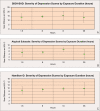Air ions and mood outcomes: a review and meta-analysis
- PMID: 23320516
- PMCID: PMC3598548
- DOI: 10.1186/1471-244X-13-29
Air ions and mood outcomes: a review and meta-analysis
Abstract
Background: Psychological effects of air ions have been reported for more than 80 years in the media and scientific literature. This study summarizes a qualitative literature review and quantitative meta-analysis, where applicable, that examines the potential effects of exposure to negative and positive air ions on psychological measures of mood and emotional state.
Methods: A structured literature review was conducted to identify human experimental studies published through August, 2012. Thirty-three studies (1957-2012) evaluating the effects of air ionization on depression, anxiety, mood states, and subjective feelings of mental well-being in humans were included. Five studies on negative ionization and depression (measured using a structured interview guide) were evaluated by level of exposure intensity (high vs. low) using meta-analysis.
Results: Consistent ionization effects were not observed for anxiety, mood, relaxation/sleep, and personal comfort. In contrast, meta-analysis results showed that negative ionization, overall, was significantly associated with lower depression ratings, with a stronger association observed at high levels of negative ion exposure (mean summary effect and 95% confidence interval (CI) following high- and low-density exposure: 14.28 (95% CI: 12.93-15.62) and 7.23 (95% CI: 2.62-11.83), respectively). The response to high-density ionization was observed in patients with seasonal or chronic depression, but an effect of low-density ionization was observed only in patients with seasonal depression. However, no relationship between the duration or frequency of ionization treatment on depression ratings was evident.
Conclusions: No consistent influence of positive or negative air ionization on anxiety, mood, relaxation, sleep, and personal comfort measures was observed. Negative air ionization was associated with lower depression scores particularly at the highest exposure level. Future research is needed to evaluate the biological plausibility of this association.
Figures




Similar articles
-
Subjective response to negative air ion exposure.Aviat Space Environ Med. 1982 Aug;53(8):822-3. Aviat Space Environ Med. 1982. PMID: 7181816
-
Bright light, negative air ions and auditory stimuli produce rapid mood changes in a student population: a placebo-controlled study.Psychol Med. 2006 Sep;36(9):1253-63. doi: 10.1017/S0033291706008002. Epub 2006 Jun 7. Psychol Med. 2006. PMID: 16756690 Clinical Trial.
-
Controlled trial of naturalistic dawn simulation and negative air ionization for seasonal affective disorder.Am J Psychiatry. 2006 Dec;163(12):2126-33. doi: 10.1176/ajp.2006.163.12.2126. Am J Psychiatry. 2006. PMID: 17151164
-
Poor sleep quality is associated with perinatal depression. A systematic review of last decade scientific literature and meta-analysis.J Perinat Med. 2019 Sep 25;47(7):689-703. doi: 10.1515/jpm-2019-0214. J Perinat Med. 2019. PMID: 31393835
-
Telephone interventions for symptom management in adults with cancer.Cochrane Database Syst Rev. 2020 Jun 2;6(6):CD007568. doi: 10.1002/14651858.CD007568.pub2. Cochrane Database Syst Rev. 2020. PMID: 32483832 Free PMC article.
Cited by
-
Natural environments, ancestral diets, and microbial ecology: is there a modern "paleo-deficit disorder"? Part II.J Physiol Anthropol. 2015 Mar 10;34(1):9. doi: 10.1186/s40101-014-0040-4. J Physiol Anthropol. 2015. PMID: 25889196 Free PMC article. Review.
-
The Interplay between Housing Environmental Attributes and Design Exposures and Psychoneuroimmunology Profile-An Exploratory Review and Analysis Paper in the Cancer Survivors' Mental Health Morbidity Context.Int J Environ Res Public Health. 2021 Oct 16;18(20):10891. doi: 10.3390/ijerph182010891. Int J Environ Res Public Health. 2021. PMID: 34682637 Free PMC article. Review.
-
Residential green space quantity and quality and symptoms of psychological distress: a 15-year longitudinal study of 3897 women in postpartum.BMC Psychiatry. 2018 Oct 26;18(1):348. doi: 10.1186/s12888-018-1926-1. BMC Psychiatry. 2018. PMID: 30367610 Free PMC article.
-
Selecting, implementing and evaluating control and placebo conditions in light therapy and light-based interventions.Ann Med. 2024 Dec;56(1):2298875. doi: 10.1080/07853890.2023.2298875. Epub 2024 Feb 8. Ann Med. 2024. PMID: 38329797 Free PMC article. Review.
-
Does waterfall aerosol influence mucosal immunity and chronic stress? A randomized controlled clinical trial.J Physiol Anthropol. 2017 Jan 13;36(1):10. doi: 10.1186/s40101-016-0117-3. J Physiol Anthropol. 2017. PMID: 28086991 Free PMC article. Clinical Trial.
References
-
- Bracken TD. In: Air Ions: Physical and Biological Aspects. Charry JM, Kavet R, editor. Boca Raton: CRC Press; 1987. Small Air Ion Properties.
-
- Bracken TD, Johnson GB. In: Air Ions: Physical and Biological Aspects. Charry JM, Kavet R, editor. Boca Raton: CRC Press; 1987. Small Air Ion Environments; pp. 13–21.
-
- Chalmers JA. Atmospheric Electricity. New York: Pergamon Press; 1967.
-
- Flory R, Ametepe J, Bowers B. A randomized, placebo-controlled trial of bright light and high-density negative air ions for treatment of Seasonal Affective Disorder. Psychiatry Res. 2010;177(1–2):101–108. - PubMed
Publication types
MeSH terms
LinkOut - more resources
Full Text Sources
Other Literature Sources

